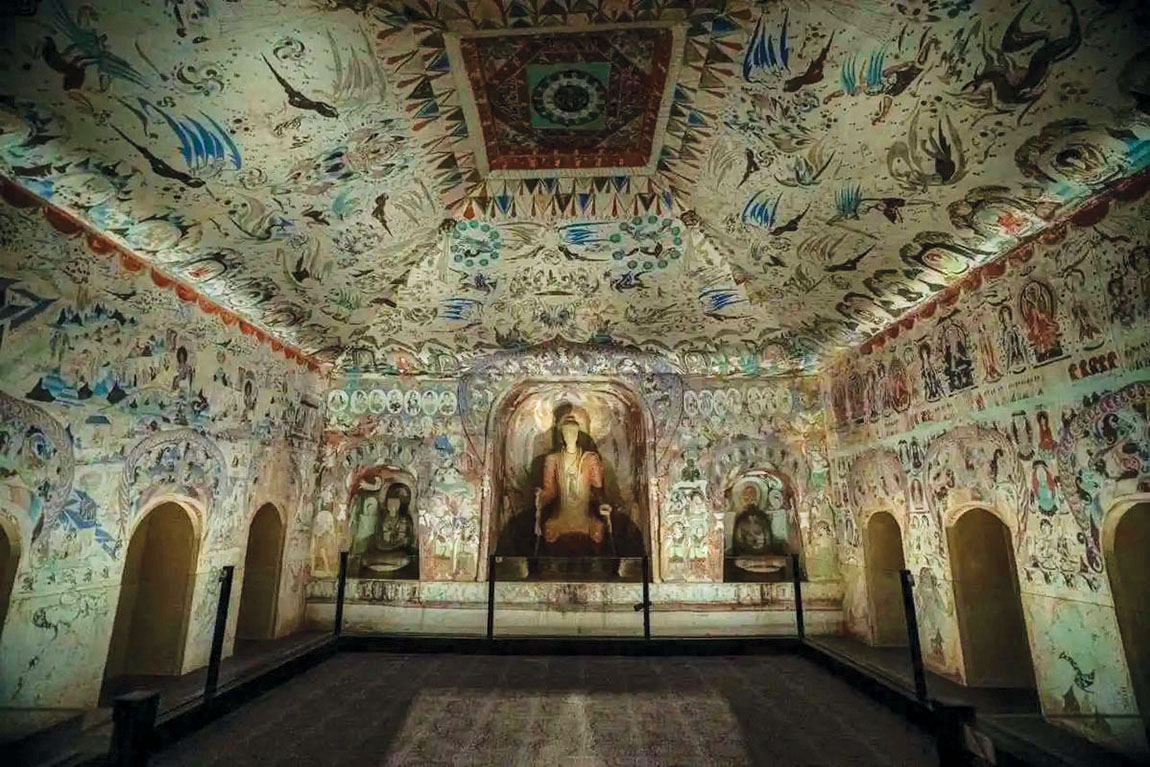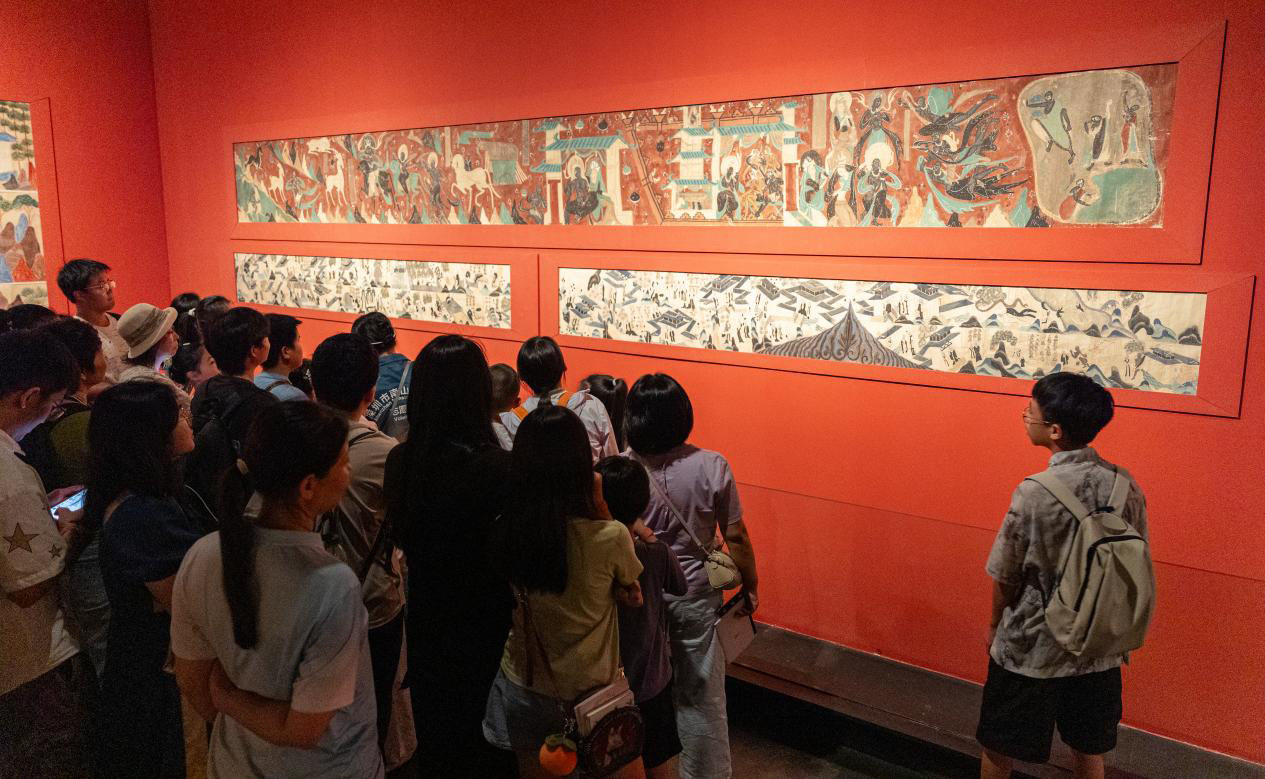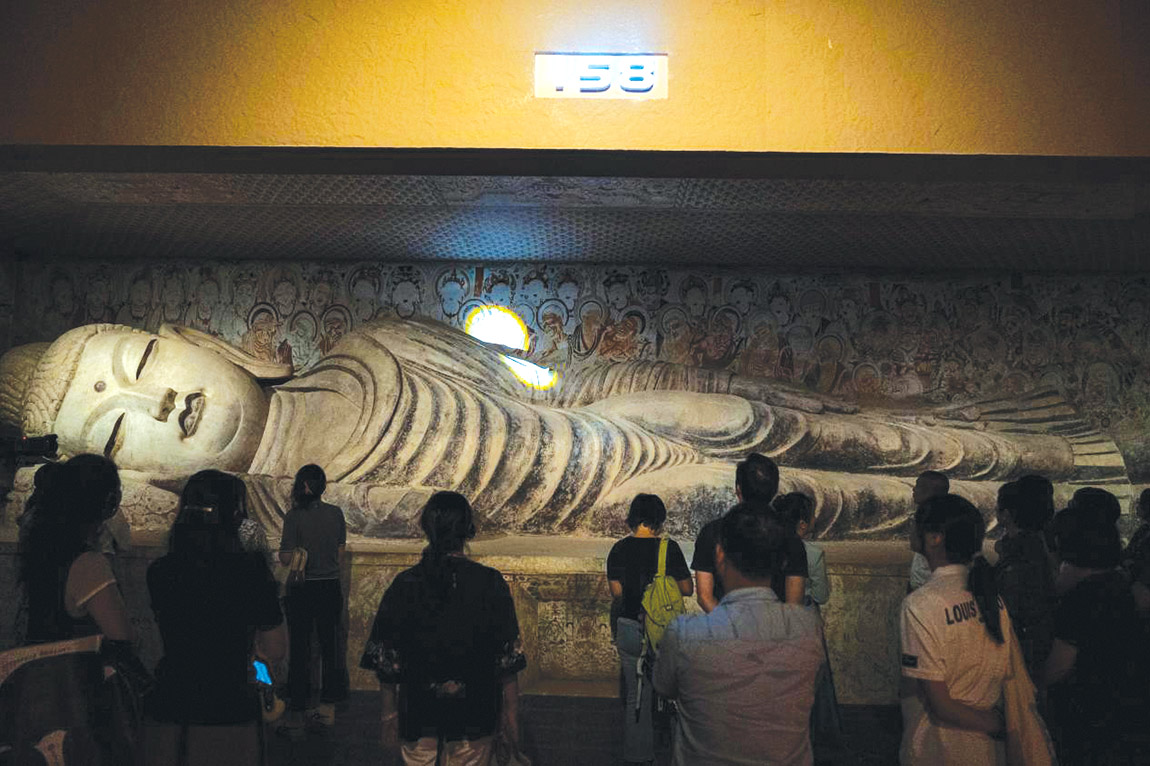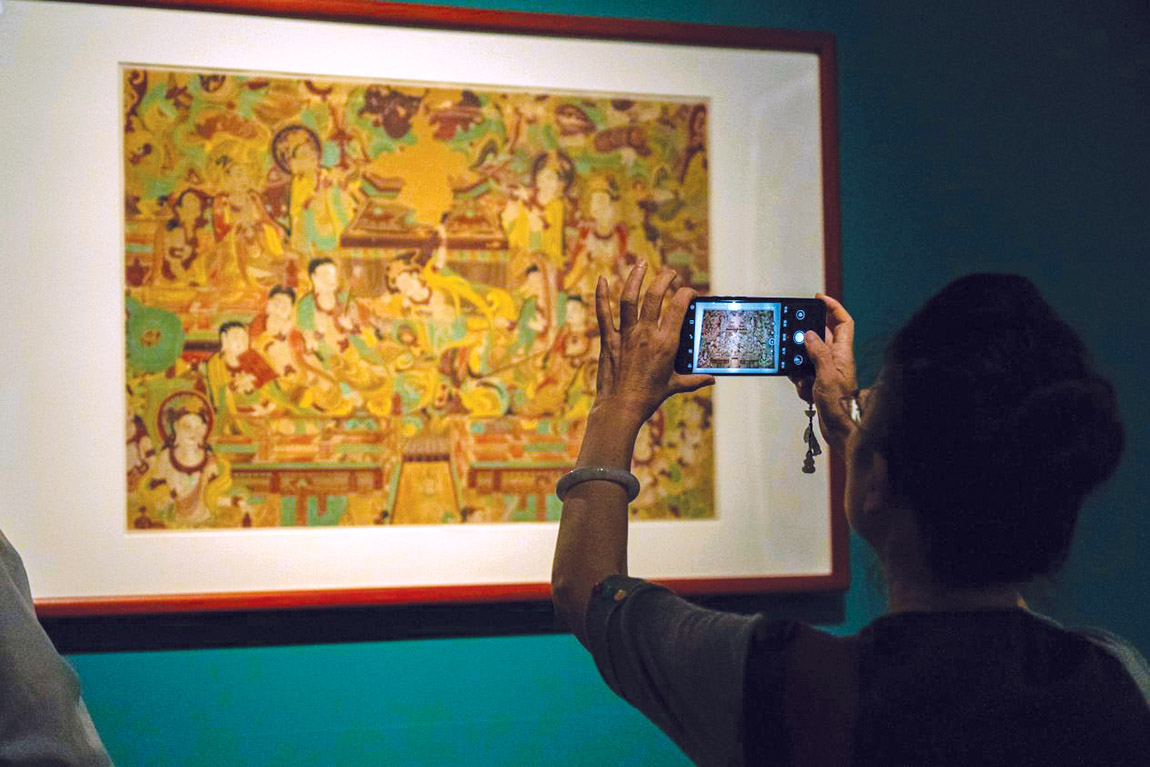Ancient treasures from the Silk Road cultural oasis Dunhuang are on display at an exhibition in Shenzhen, highlighting the town’s rich religious and cultural heritage — a hallmark of Chinese civilization. Li Bingcun reports.

Despite being thousands of miles apart, Dunhuang — famed for the Mogao Caves — and the Guangdong-Hong Kong-Macao Greater Bay Area have found themselves intertwined through a cultural exhibition, allowing visitors in southern China to engage with the Silk Road cultural oasis where global civilizations converge.
Immersing themselves in stunning cave art featuring elaborate ceiling designs, murals and sculptures, visitors can quietly appreciate the ancient artifacts on display, uncovering the breathtaking beauty of this treasure trove of artifacts.
These preserved histories continue to fascinate visitors a thousand years after their making — igniting interest in Chinese culture, fostering aesthetic appreciation, and inspiring cultural and artistic industries to better present Chinese heritage.
Dunhuang Splendors: Culture and Art Exhibition of Mogao Grottoes — South China’s largest exhibition of Dunhuang heritage — is being held at Shenzhen’s Nanshan Museum.
READ MORE: Soccer giants’ clash in HK, GBA dance festival & Dunhuang splendors in SZ
Running from July to November, visitor numbers for the four-month exhibition are expected to reach a new high during this year’s eight-day National Day and Mid-Autumn Festival holidays from Oct 1 to 8. A special night session will be held on Oct 6 — the Mid-Autumn Festival — offering intangible cultural heritage performances and free guided services. Visitor numbers had already exceeded 120,000 towards the end of last month.
The exhibition showcases over 200 precious artifacts, including national treasures and digital displays making their debut in the Greater Bay Area. Cultural relics unearthed from the northern section of the Mogao Grottoes are also being displayed for the first time in major museums on the Chinese mainland and overseas.
At the heart of the exhibition are six specially protected, restored caves. Cave 285, described as the pantheon of Chinese mythology, and Cave 3, featuring a vividly sculpted Avalokitesvara, are inaccessible to the public in Dunhuang for preservation purposes.
Cave 158 contains a 15-meter-long reclining Buddha sculpture with a serene expression and a gentle smile, depicting the process of Shakyamuni’s nirvana. The oldest cave, Cave 275, has been digitally rendered for the first time, with the contents displayed on a large screen.
The exhibition provides a comprehensive overview of Dunhuang’s significance on the Silk Road, highlighting its religious importance, reflections of ancient social development, the treasures of the Mogao Caves, and archaeological processes and conservation efforts.

Living heritage
The organizers invited professional tour guides from Dunhuang Academy to show visitors around and provide lectures and public educational activities about Dunhuang’s influence in art, history, culture and conservation.
As part of the upgrading of cultural services, Nanshan Museum has introduced admission fees for the first time for the exhibition, with tickets priced at between 49 yuan ($6.88) and 98 yuan. Several other public museums in Shenzhen have also launched or are preparing to introduce admission fees.
A visitor named Wu, who took her 8-year-old son to the exhibition, said they planned to visit Dunhuang and other historic sites in Gansu province this summer. She carried a book about the history of the Hexi Corridor — a vital ancient Silk Road passageway in Gansu province — stamped with numerous seals from the exhibition.
A fan of heritage sites across the nation, Wu is racing against time to appreciate the valuable relics with her children before public viewing is restricted for conservation purposes. Hanging Temple in Shanxi province — an architectural marvel built into a cliff — began limiting visitor numbers in July as part of a conservation process.
Wu said the exhibition is rich in detail, offering a deep insight into Dunhuang’s culture. Besides the magnificent artistry of the exhibits, the exhibition includes information on the archaeological process, and explanations of Buddhist stories. Signs even depict a Buddha’s hand to remind visitors not to touch the artifacts.
Wu said she believes charging an admission fee could enhance the exhibition experience and attract genuine Dunhuang enthusiasts. To better engage younger audiences, she suggests that interactive experiences and technological elements be enhanced. A frequent museum goer, she hopes Nanshan Museum can launch exhibitions about ethnic minorities, illustrating the diversity of Chinese culture.

Another visitor, named Xiang, used the visit to gather inspiration for a new mobile game set against the backdrop of ancient China. Visiting along with other designers from a game development company, he said the vibrant colors, intricate patterns and distinctive styling of Dunhuang art serve as a rich source of creativity to design game maps and figures of the country’s western regions.
He said games featuring traditional Chinese culture have enjoyed great popularity, including Black Myth: Wukong, a global hit inspired by the 16th-century Chinese novel Journey to the West, that faithfully recreates ancient Chinese architecture.
“Players feel that a game’s authenticity increases with its adherence to historical culture,” said Xiang, who had earlier missed out on an exhibition in Hangzhou displaying the art design of Black Myth: Wukong. The Dunhuang exhibition in Shenzhen offers another valuable opportunity for learning.
Xiang said Dunhuang can provide rich design inspiration for a wide range of cultural and entertainment industries, including animation, film and television, literature and advertising.
According to Wu Sujuan, a professional tour guide from the Dunhuang Academy, most of the visitors have never been to Dunhuang. She said the greatest significance of the exhibition is allowing people to appreciate Dunhuang cave art at their doorstep, enriching their experience for future on-site trips.
Responding to visitors’ desire to see more authentic artifacts at the exhibition, Yang Xiaorong, another tour guide from Dunhuang, emphasized that for artifacts that cannot be moved, copying, reproduction and digital presentation are the best ways to promote them.
“To make Dunhuang known to the world, these approaches are essential. Otherwise, people around the world can only visit Dunhuang themselves,” she said.

Expanding influence
From June to September, the University of Hong Kong also held a three-month exhibition to recreate the grandeur of Dunhuang.
Wu called Dunhuang a “hallmark of Chinese civilization”, the promotion of which should not be limited by geographical boundaries. She added that she hopes deeper collaboration can be forged among Shenzhen, Hong Kong and other cities in the Greater Bay Area to advance Dunhuang culture.
ALSO READ: Culture with tech triumphs at ICIF in Shenzhen
The Greater Bay Area has rich museum resources and strong international connections. If the cluster can integrate the strengths of each of the 11 cities and organize Dunhuang tour exhibitions in diverse forms, along with academic seminars, public education activities, and digital experiences, the efficiency and impact of promoting Dunhuang culture can be greatly enhanced, Wu said.
Contact the writer at bingcun@chinadailyhk.com


